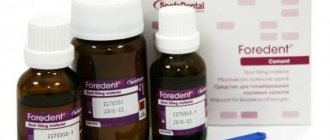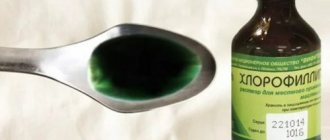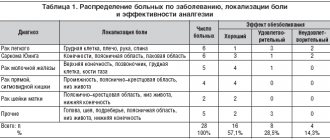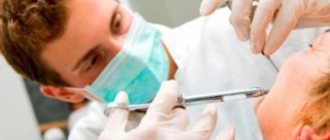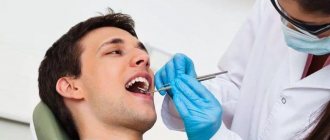Decasan is prescribed to children for the treatment of diseases of the skin, oral mucosa, and respiratory infections. The drug has antimicrobial and disinfecting properties. Can be used as a solution for inhalation and local antiseptic, rinsing, and dripping into the nose. Available in bottles of 50-400 ml, containers of 50-1000 ml, and also in nebulas of 2 ml. The price of the drug is 119-135 rubles.
Decasan is absolutely safe for use by newborns and children up to one year old.
Pharmacological properties of the drug Dekasan
Decamethoxin ([1,10-Decamethylene-(N,N-dimethylmentoxycarbonylmethyl) ammonium dichloride]) is an antiseptic, bis-quaternary ammonium derivative. Concentrating on the cytoplasmic membrane of the microbial cell, it binds to the phosphatidic groups of membrane lipids and disrupts its permeability. Decamethoxin has a pronounced bactericidal effect on staphylococci, streptococci, diphtheria and Pseudomonas aeruginosa, capsular bacteria and a fungicidal effect on yeast fungi, pathogens of epidermophytosis, trichophytosis, microsporia, erythrasma, some types of mold fungi (Aspergillus, penicillium), antiprotozoal effect on Trichomonas, Giardia, viricidal effect on viruses. Highly active against microorganisms resistant to antibiotics (penicillin, chloramphenicol, tetracyclines, streptomycin, monomycin, kanamycin, neomycin, novobiocin, erythromycin, oleandomycin, etc.). The formation of decamethoxin-resistant forms of microorganisms with long-term use occurs slowly. Bacteriostatic (fungistatic) concentrations of the drug are close to its bactericidal (fungicidal), viricidal, antiprotozoal concentrations. During treatment with Decasan, the sensitivity of antibiotic-resistant microorganisms to antibiotics increases. When used externally in the form of rinses or lotions, the drug is practically not absorbed through intact skin, mucous membranes and wound surfaces.
Side effects
The antiseptic drug Decasan rarely causes side effects. Sometimes symptoms of allergic reactions to the active substance of the drug may occur: redness of the skin, itching, rash, urticaria. Side effects do not require special treatment and disappear on their own after completing the course of treatment.
If the drug is used in the form of inhalations or nasal drops, after the procedure the child may feel a burning sensation in the chest and nasal cavity. Such symptoms go away on their own within half an hour.
Decasan has virtually no contraindications and is safe for children of any age, except for patients with individual intolerance to the drug.
Indications for use of the drug Decasan
Pustular bacterial and fungal skin diseases, microbial eczema, purulent-inflammatory lesions of soft tissues (abscess, carbuncle, phlegmon, boil, infected wounds, felon). The drug is prescribed for diseases of the oral cavity (stomatitis, ulcerative necrotizing gingivitis, dystrophic-inflammatory form of periodontal disease I–II degrees in the acute phase). Decasan is also used for lung abscess, bronchiectasis, cystic hypoplasia of the lungs, complicated by suppuration, chronic bronchitis in the acute phase, chronic tonsillitis, tonsillitis, carriage of staphylococci and diphtheria bacilli, nonspecific ulcerative colitis, paraproctitis. For surgical infectious and inflammatory diseases of the abdominal cavity (peritonitis of various etiologies) and in pulmonology, Decasan is used for washing the abdominal and pleural cavities. In urology, the drug is used for urethritis (for instillations into the urethra), balanaposthitis (for baths), prostatitis (for microenemas), cystitis (for instillations into the bladder), and for irrigation of the bladder in the postoperative period. In gynecological practice, Dekasan is used for the treatment of candidiasis of the vaginal mucosa, inflammatory diseases of the external genitalia of microbial etiology, prenatal sanitation of the birth canal, and treatment of postpartum endometritis. Decasan is used to disinfect the skin of medical staff's hands and rubber gloves when examining patients and performing medical procedures, small-scale surgical interventions, pre-sterilization disinfection of medical instruments and diagnostic equipment made of metal, rubber, polymeric materials and glass.
Actual information
Decasan (active ingredient - decamethoxin), according to the AT classification, belongs to the group of antiseptic and disinfectant medicines. it has a wide range of antimicrobial, antifungal and antiviral effects due to the ability to interact with phosphate groups of lipids of the cytoplasmic membrane of microorganisms and thus disrupt its permeability and lead to cell destruction. decamethoxin has been used in clinical practice since the 1970s to the present day with consistently high efficiency and has a wide range of indications for use.
Mechanism of action of decamethoxin
As a result of research, it was found that decamethoxin has a bactericidal effect on Pseudomonas aeruginosa, as well as Escherichia coli and Micrococcus lysodeikticus. Due to the fact that decamethoxin is a surfactant, it changes the permeability of the pathogen membrane, leading to the destruction and death of the microorganism, which determines its bactericidal effect (Shchetina VN et al., 1990). The bacteriostatic effect is due to the following mechanisms: inactivation of pathogen exotoxins (Kovalchuk V.P., 2002); reduction of adhesion of pathogenic microorganisms (Zhornyak OI et spivat., 2010).
An in vitro study demonstrated the antifungal effectiveness of decamethoxin against Candida fungi isolated from patients with chronic intestinal diseases. It has also been established that drug resistance to decamethoxin develops very slowly and does not reach a high level (Palii GK, Ivanova SA, 1986).
The effectiveness of Decasan in surgery
A recent clinical study presents the experience of treating 17 patients with cholangitis of various origins using the antiseptic Decasan
. The clinical effectiveness of the drug in the complex therapy of cholangitis was noted, confirmed by the results of a bacteriological study of bile (Aripova NU, Magzumov I.Kh., 2014).
Efficiency of Dekasan
in the treatment of cholangiogenic liver abscess was demonstrated in a clinical study.
The results of treatment of 47 patients with cholangiogenic liver abscess are described. The study proved the effectiveness of sanitation of the abscess cavity with Decasan
(Nychytailo MI et al., 2005),
Dekasan
proposed for use in the complex treatment of infected pancreatic necrosis and its complications (Nichitailo ME, 2010), as well as in the treatment of acute abdominal infectious pathologies of various origins (Fomin PD et al., 2009).
Another study presents the results of complex therapy of 37 patients operated on due to the development of acute abdominal surgical diseases. 22 patients received local therapy with a 0.02% antiseptic solution of decamethoxin. There was a positive effect on the clinical course of diseases, a decrease in the frequency of purulent-septic complications, in particular in patients operated on for acute necrotizing pancreatitis (Konovalov EP, 2004).
The experience of treating 91 patients with peritonitis of various origins using the antiseptic Decasan
. There was marked clinical effectiveness compared to other antiseptics in the complex treatment of peritonitis (Nazirov FN, 2014).
Based on the analysis of research results, it was found that the use of a cationic antiseptic solution (including a 0.02% decamethoxin solution) for sanitation of the abdominal cavity can reduce microbial contamination during sanitation, and also due to this, the frequency of postoperative complications in surgical peritonitis and the number of cases of lethal outcome (Boiko VV et al., 2012).
of Decasan was analyzed in 102 patients
in the treatment of purulent infections of the pararectal area.
According to the data obtained, Decasan
is an effective drug for local therapy of this pathology (Zakharash MP, 2011).
Decamethoxin has also proven itself as an effective drug for preventing suppuration of postoperative wounds after excision of pararectal or coccygeal epithelial cysts (Klimenko AN, Iukhimets AD, 1982).
In one of the clinical studies, the effectiveness of Decasan
in complex therapy of soft tissue necrosis, which resulted in sepsis.
Sepsis is a severe generalized infection usually caused by pathogenic bacteria. It often causes hospitalization and death. The experience gained as a result of the study contributed to a better understanding of the pathomechanisms of this condition, the development of therapy aimed at improving the general condition of patients, and also necessarily including the local use of antibacterial and antiseptic agents in the purulent focus. The study included 192 patients (103 women, 89 men). According to the classification of septic conditions (Chicago, 1991), patients were divided into 3 groups: group 1 - with a local form of infection, group 2 - with systemic inflammatory response syndrome (SIRS, English abbreviation SIRS), which lasts up to 72 hours , 3rd group - with various forms of sepsis, in which SIRS lasts 72 hours or more. In patients whose wounds were treated with Decasan
, a decrease in the severity of pain, tissue swelling, early sanitation of the wound and early appearance of granulation in the wound were noted.
The algorithm for the treatment of sepsis proposed by the authors includes an integrated approach to the treatment of infection through early surgical intervention, intensive supportive care, etiotropic antibacterial therapy and local use of antiseptic therapy with Decasan
.
As a result, it was concluded that Decasan
can be recommended for the disinfection of skin, mucous membranes and wounds in areas of infection caused by bacteria, fungi and protozoa (Fuss J., 2016).
Decamethoxin can also be used to treat burn disease. One clinical study identified the etiology of infectious complications in 71 patients with severe burns. It has been established that the main causative agents of infection in patients with burn disease are S. aureus (35.9%), A. baumannii (25%), P. aeruginosa (12.82%), P. mirabilis (5.12%). Decasan antiseptic solutions has been proven
, miramistin, chlorhexidine. In relation to staphylococcus, high antimicrobial properties of dressing materials, which contain ions of decamethoxin, chlorhexidine, furagin, and silver, have been noted. The clinical effectiveness of the use of materials impregnated with the antimicrobial composition decamethoxin with carboxymethyl starch, hydroxyethylcellulose and polyvinyl acetate, used for the prevention and treatment of infectious-purulent-inflammatory complications in patients with burns, has been proven (Nazarchuk OA, 2016).
Another study presented the results of an observation of 154 patients with open traumatic brain injury. The effectiveness of decamethoxin in patients with purulent-inflammatory complications was confirmed (Pedachenko EG et al., 1992).
Decamethoxin has been widely used as an antiseptic in surgery for many years. Thus, in a clinical study, the advantages of its use in the treatment of purulent processes on the hand (Kravets VP, 1987) and in the complex treatment of complicated forms of paronychia (Palii GK et al., 1988) were demonstrated.
In another study, which involved 286 patients with purulent-inflammatory diseases of the fingers and hands (196 patients (68.5%) with panaritium, 82 (28.7%) with phlegmon and abscesses, 6 (2.1 %) - with boils and 2 (0.7%) - with carbuncles), the effectiveness of the use of decamethoxin as part of the complex treatment of this pathology was confirmed (Fishchenko A. et al., 1992).
The effectiveness of decamethoxin in the treatment of respiratory diseases
Decamethoxin has also demonstrated its effectiveness in otolaryngology. Clinical studies have shown the effectiveness of the use of decamethoxin by inhalation in the treatment of nonspecific diseases of the respiratory tract in children (Kravets AA et al., 1976).
Decamethoxin has demonstrated effectiveness in the treatment of diseases of the oral mucosa (Palii GK et al., 1975), as well as in the treatment of chronic tonsillitis (Zubovich AP, 1978). Studies have determined the sensitivity of pathogenic microflora isolated from children with respiratory tract diseases to decamethoxin (Palii GK, 1974). Decamethoxin can be used for preoperative preparation of patients with nonspecific respiratory diseases (Iukhimets VA, 1985).
Decamethoxin in complex therapy combined with antibiotics is effective in the treatment of purulent-inflammatory diseases of the respiratory system (Radionov BV et al., 1986). The effectiveness of decamethoxin in the complex treatment of chronic bronchitis has also been confirmed by clinical studies. The study involved 72 patients with chronic bronchitis (catarrhal, purulent, and purulent bronchitis complicated by purulent destructive processes). All patients received complex therapy using decamethoxin as a local antibacterial agent. This study found that the inclusion of decamethoxin in complex therapy is effective not only due to its direct antiseptic effect, but also due to the fact that this drug reduces the resistance of microorganisms to antibiotics (Iukhimets VA, Pilipchuk VN, 1990).
Dekasan
has a very wide range of indications for use.
Thus, the use of decamethoxin in the complex therapy of chronic gastritis in combination with biliary tract pathology was proposed (Mokhun' IK et al., 1982). Safety of Decasan established as a result of research
Currently, special attention is paid to the safety of the use of local antiseptics and their effect on the cell cycle, as well as indicators such as DNA fragmentation and apoptosis. In a study on rats, it was demonstrated that Decasan
with higher antimicrobial effectiveness, it is a safer antiseptic than Miramistin. It was demonstrated using flow cytometry that decamethoxin had a minimal proapoptotic effect on rat corneal cells after 2 weeks of drug use. It was also noted that the decrease in cell proliferation was insignificant, as was the increase in nuclear DNA fragmentation. This indicates the absence of the cytotoxic effect of decamethoxin. When studying similar parameters after the use of miramistin, a decrease in the mitotic activity of cells, a significant increase in DNA fragmentation and an increase in apoptosis were revealed, which indicates a higher safety profile of decamethoxin compared to miramistin.
A morphological study was carried out to study the local effect on tissue. Special textiles were impregnated with a mixture of decamethoxin and modified polysaccharides. Based on the results of the study, it was found that there is no toxic effect of antiseptic medical textiles impregnated with decamethoxin on the tissue of the macroorganism. At the same time, a positive effect was observed on the course of regenerative processes, epithelization of wounds, anti-edematous and anti-inflammatory effects (Nazarchuk OA, 2013).
conclusions
Dekasan
- an antiseptic indicated for use in a wide range of infectious and inflammatory diseases.
Its effectiveness and safety have been confirmed in clinical studies. The use of Decasan
for local sanitation of the source of infection can reduce the need for antibiotics, as well as increase the sensitivity of microorganisms to antibiotics when used in combination with
Decasan
.
This drug has no toxic effect. The only contraindication for use is individual intolerance to decamethoxin. There are no restrictions on the use of Decasan
during pregnancy and lactation.
As a surface-active cationic antiseptic, Decasan
is incompatible with soap and other anionic surfactants.
Product description certified by the manufacturer Yuria Pharm
.
Verified by
Likar Turumkulova Irina
Use of the drug Decasan
For purulent and fungal skin lesions and infected wounds, the solution is used for rinsing and lotions. To wash the bladder, decamethoxin solution is used after preliminary dilution 1:7 with purified water in an amount of 500–600 ml (7–20 washes per course of treatment). For the treatment of proctitis and ulcerative colitis, a warm solution is administered as an enema, 50–100 ml 2 times a day until the symptoms of exacerbation of the disease are completely eliminated. Fistulas with chronic paraproctitis are washed with Decasan daily for 3–4 days. For lesions of the oral mucosa, it is used in the form of applications of 25–50 ml for 10–15 minutes or rinses (100–150 ml). In the dystrophic-inflammatory form of periodontal disease I–II degrees in the acute phase, irrigation with a warm solution of pathological gum pockets (50–70 ml) or applications to the gums is carried out until the severity of inflammatory phenomena decreases. Patients with candidiasis of the oral mucosa and ulcerative-necrotizing gingivitis are prescribed mouth rinse (100–150 ml) 4 times a day for 5–10 days. Treatment of candidiasis of the palatine tonsils and chronic tonsillitis is carried out by washing the lacunae of the palatine tonsils (50–75 ml per rinse). When carrying staphylococcus or diphtheria bacillus, sanitation is carried out by rinsing the pharynx with solution, washing the lacunae, irrigating the nasopharynx and tonsils. Lacunae are washed 3-5 times every other day. For lung abscess, bronchiectasis, cystic pulmonary hypoplasia complicated by suppuration, chronic bronchitis in the acute phase, Decasan is administered endobronchially:
- through a microtracheostomy - 25–50 ml 1–2 times a day;
- through a transnasal catheter - 5–10 ml once a day;
- by ultrasonic inhalation - 5-10 ml 1-2 times a day;
- using lavage of the tracheobronchial tree - in a volume of 100 ml.
Duration of treatment is 2–4 weeks. For the treatment of microbial, fungal and trichomonas vaginitis, Decasan is used in the form of douching (50–100 ml of the drug heated to 38 °C 3 times a day). In the same way, prenatal sanitation of the birth canal is carried out once. Treatment of postpartum endometritis is carried out by washing the uterine cavity with a warm preparation (150–200 ml) 2 times a day. Disinfection of the skin of hands and rubber gloves is carried out by applying 5–10 ml of the drug to a previously washed surface, evenly distributing it over the entire surface to be disinfected for 5 minutes. Cleaned medical instruments, mouthpieces, tubes and equipment are disinfected by immersion in the solution for 30 minutes.
Note!
Description of the drug Decasan solution 0.2 mg/ml bottle. 100ml on this page is a simplified author’s version of the apteka911 website, created on the basis of the instructions for use.
Before purchasing or using the drug, you should consult your doctor and read the manufacturer's original instructions (attached to each package of the drug). Information about the drug is provided for informational purposes only and should not be used as a guide to self-medication. Only a doctor can decide to prescribe the drug, as well as determine the dose and methods of its use.
For children
Decasan for nebulizer is actively used in pediatric practice, since it is the optimal form of spraying a pharmaceutical drug for the gentle elimination of pathologies of the respiratory tract , because the mucous membrane is not yet fully developed during certain periods of growing up (this method of administration allows you to get rid of some possible adverse effects of therapy). convenient for children to use Dekasan for a nebulizer than nasal drops or any other methods of delivering the active components of the drug to the affected layers of the bronchial tree , because it is quite difficult to sit a small child in one position for a long time and correctly insert a catheter into the child’s nose, for example.
In turn, during inhalation with a nebulizer, children can maintain a moderate level of activity It is also possible to watch cartoons or read books, because the mask of the device is practically not felt on the face after the first inhalation.
Decasan for inhalation for children, of course, should be diluted somewhat stronger than for adult patients. As a rule, half dosages of the drug are used, but for precise instructions you should additionally consult a qualified pediatrician.
Analogs
Dekasan is supplied from Ukraine (Yuria Pharm enterprise). It is difficult to purchase in Russia. But active, approximate analogues from Russian suppliers with the possibility of using for gargling are: Furacilin, Chlorhexidine, Dioxidin, Chlorophyllipt.
The Miramistin analogue can be administered through a nebulizer. Furacilin in a ready-made sterile solution is available by prescription and is also used for rinsing.
Other drugs to replace:
- Septefril, an antiseptic in lozenges for the treatment and prevention of infectious and inflammatory pathologies of the pharyngeal cavity (oral cavity), tonsillitis, sore throat, pharyngitis.
- Dexamethasone (soluble tablets, alcohol solution) is a disinfecting antiseptic for inflammation of hard tooth tissue, conjunctiva, mycotic and bacterial diseases of the skin.
- Aquazan containing active povidone-iodine (solution) for local, external use.
- Amident (Russian analogue) with active chlorhexidine. Antiseptic solution that is active against gram-negative and gram-positive bacteria. Can be used by children, women during pregnancy and breastfeeding.

